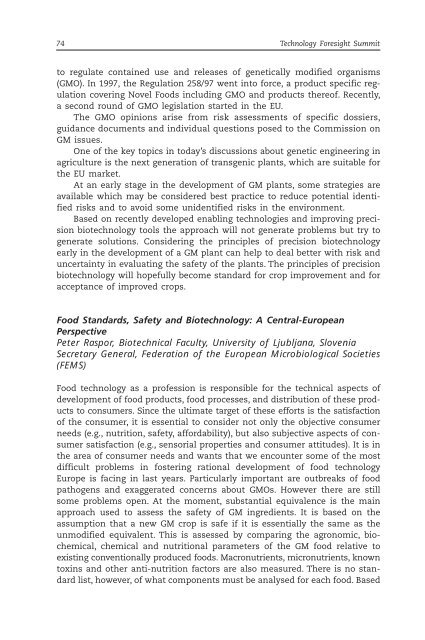TECHNOLOGY FORESIGHT SUMMIT - Unido
TECHNOLOGY FORESIGHT SUMMIT - Unido
TECHNOLOGY FORESIGHT SUMMIT - Unido
Create successful ePaper yourself
Turn your PDF publications into a flip-book with our unique Google optimized e-Paper software.
74 Technology Foresight Summit<br />
to regulate contained use and releases of genetically modified organisms<br />
(GMO). In 1997, the Regulation 258/97 went into force, a product specific regulation<br />
covering Novel Foods including GMO and products thereof. Recently,<br />
a second round of GMO legislation started in the EU.<br />
The GMO opinions arise from risk assessments of specific dossiers,<br />
guidance documents and individual questions posed to the Commission on<br />
GM issues.<br />
One of the key topics in today’s discussions about genetic engineering in<br />
agriculture is the next generation of transgenic plants, which are suitable for<br />
the EU market.<br />
At an early stage in the development of GM plants, some strategies are<br />
available which may be considered best practice to reduce potential identified<br />
risks and to avoid some unidentified risks in the environment.<br />
Based on recently developed enabling technologies and improving precision<br />
biotechnology tools the approach will not generate problems but try to<br />
generate solutions. Considering the principles of precision biotechnology<br />
early in the development of a GM plant can help to deal better with risk and<br />
uncertainty in evaluating the safety of the plants. The principles of precision<br />
biotechnology will hopefully become standard for crop improvement and for<br />
acceptance of improved crops.<br />
Food Standards, Safety and Biotechnology: A Central-European<br />
Perspective<br />
Peter Raspor, Biotechnical Faculty, University of Ljubljana, Slovenia<br />
Secretary General, Federation of the European Microbiological Societies<br />
(FEMS)<br />
Food technology as a profession is responsible for the technical aspects of<br />
development of food products, food processes, and distribution of these products<br />
to consumers. Since the ultimate target of these efforts is the satisfaction<br />
of the consumer, it is essential to consider not only the objective consumer<br />
needs (e.g., nutrition, safety, affordability), but also subjective aspects of consumer<br />
satisfaction (e.g., sensorial properties and consumer attitudes). It is in<br />
the area of consumer needs and wants that we encounter some of the most<br />
difficult problems in fostering rational development of food technology<br />
Europe is facing in last years. Particularly important are outbreaks of food<br />
pathogens and exaggerated concerns about GMOs. However there are still<br />
some problems open. At the moment, substantial equivalence is the main<br />
approach used to assess the safety of GM ingredients. It is based on the<br />
assumption that a new GM crop is safe if it is essentially the same as the<br />
unmodified equivalent. This is assessed by comparing the agronomic, biochemical,<br />
chemical and nutritional parameters of the GM food relative to<br />
existing conventionally produced foods. Macronutrients, micronutrients, known<br />
toxins and other anti-nutrition factors are also measured. There is no standard<br />
list, however, of what components must be analysed for each food. Based

















